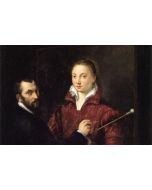Representing nature in early modern Europe

- Course Code: VB901
- Dates: 07/06/24 - 05/07/24
- Time: 10:30 - 12:30
- Taught: Fri, Daytime
- Duration: 5 sessions (over 5 weeks)
- Location: Keeley Street
- Tutor: Thomas Balfe
Course Code: VB901
Duration: 5 sessions (over 5 weeks)
Please note: We offer a wide variety of financial support to make courses affordable. Just visit our online Help Centre for more information on a range of topics including fees, online learning and FAQs.
What is the course about?
In sixteenth- and seventeenth-century Europe, ideas about nature were in a state of transition. The drivers of change were technological, economic and political. In this period, developments in mapping, and the microscope, telescope and camera obscura, were generating new visions of nature based on empirical observation. There was increasing contact between European travellers and non-European lands, fuelling a rich tradition of travel literature. The strengthening of emotional attitudes towards certain animals and natural environments (e.g. the forest as a national symbol) also complicated existing philosophical and theological ideas of nature and its role in human affairs.
Paintings, prints and book illustrations, as well as objects fashioned directly from natural materials such as life casts, played a key role in bringing these new attitudes and forms of knowledge to a wider audience. The visual materials in this area are enormously rich. They range from Albrecht Dürer’s pioneering nature studies, to the maps and globes produced by specialist firms in Amsterdam and Antwerp, to the depictions of objects observed with the microscope that Robert Hooke created for the Royal Society in London, to the innovative etchings of the Dutch countryside that Rembrandt sold to the affluent citizens of Amsterdam. We will look at a series of case studies that focus on representations of forests, gardens, landscapes, animals and insects in a variety of media.
What will we cover?
• We will discuss the importance of technologies, such as the microscope and the map, in generating new visions of nature during the sixteenth and seventeenth centuries.
• We will look at the work of some of the most innovative artists involved in representing nature in the period.
• We will analyse selected visual examples, including paintings, prints, drawings and three-dimensional representations of natural objects.
What will I achieve?
By the end of this course you should be able to...
By the end of this course you should be able to:
· Discuss the connections that existed between new technologies and the innovative ways of depicting nature that emerged in early modern Europe, giving at least 2 examples.
· List 3 artists who were centrally concerned with representing nonhuman nature in their work.
· Visually analyse at least 2 important depictions of nature produced in the period.
What level is the course and do I need any particular skills?
This course is suitable for all levels.
You should be able to follow simple written and verbal instructions, demonstrations, handouts and health and safety information.
How will I be taught, and will there be any work outside the class?
You will be taught with lecture, slide presentations and will be invited to participate in class discussion. There will be a Google Classroom for the sharing of documents related to the course. You will be sent an invitation to the Google Classroom within a week of the course start date. You may be asked to look at some visual examples or short readings before the classes.
Are there any other costs? Is there anything I need to bring?
You might wish to have something to write with. You might wish to buy some of the books on any reading list given out in class.
When I've finished, what course can I do next?
Art and critical theory: rethinking 'nature'
Still life in the history of art: opulence and fragility.
Thomas Balfe is an art historian specialising in early modern (c.1550–c.1750) northern European easel painting and the graphic arts. His current research interests are in seventeenth-century animal, hunting, fable, and food still-life imagery, and in European visual responses to the Arctic and the Americas. His co-edited book about the written claims to lifelikeness in early modern art writing was published in 2019.
Please note: We reserve the right to change our tutors from those advertised. This happens rarely, but if it does, we are unable to refund fees due to this. Our tutors may have different teaching styles; however we guarantee a consistent quality of teaching in all our courses.
